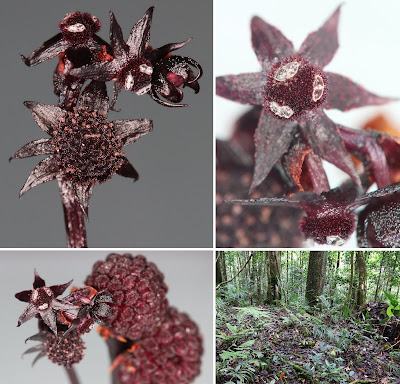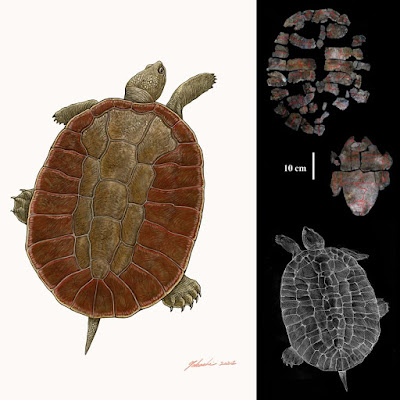[Most Recent Entries] [Calendar View]
Sunday, April 25th, 2021
| Time | Event | ||||
| 4:29p | [Botany • 2020] Sciaphila atra (Triuridaceae) • A New Mycoheterotrophic Species from Borneo
Abstract Sciaphila atra (Triuridaceae) from northern Borneo is described and illustrated. This species is similar to Sciaphila thaidanica from northern Thailand, but differs in distinctly darker stem and flowers, lower number of flowers, larger female flowers which usually have more tepals and wider tepals of male flowers. Taxonomy of Sciaphila secundiflora species complex is discussed in the paper. Key to currently accepted species of Sciaphila in Borneo is included. Keywords: Malesia, rainforest, Sarawak, Sciaphila secundiflora complex, taxonomy, Monocots Martin Dančák, Michal Hroneš and Michal Sochor. 2020. Sciaphila atra (Triuridaceae), A New Mycoheterotrophic Species from Borneo. Phytotaxa. 472(3); 277–282. DOI: 10.11646/phytotaxa.472.3.6 | ||||
| 4:29p | [Paleontology • 2021] Adocus kohaku • A New Species of Aquatic Turtle (Testudines: Cryptodira: Adocidae) from the Late Cretaceous of Kuji, Iwate Prefecture, Northeast Japan, with Special References to the Geological Age of the Tamagawa Formation (Kuji Gro
Abstract A nearly complete shell of the genus Adocus (Adocidae; Pan-Trionychia; Cryptodira; Testudines) was collected from the late Cretaceous (Turonian) Tamagawa Formation of Kuji Group at Kuji City, Iwate Prefecture, northeast Japan. This turtle shows unique features such as the loss of cervical scute, extreme expansion of marginal scutes overlying costal plates, and exclusion of the humeral- pectoral sulcus from entoplastron. Thus, Adocus kohaku is erected as a new species. As A. kohaku shows most derived position of A. kohaku within this genus, morphological diversity of the genus Adocus seems to have occurred rather early in its evolution in Eastern Asia. Keywords: Adocus kohaku sp. nov.; Cretaceous; Kuji Group; Reptilia; Testudines; U-Pb Dating Systematic Paleontology Testudines Batsch, 1788 Cryptodira Cope, 1868 Pan-Trionychia Hummel, 1929 Adocidae Cope, 1870 Type Genus. Adocus Cope, 1868 Known Distribution. Early Cretaceous to Eocene of Asia and Late Cretaceous to Paleocene of North America. Genus Adocus Cope, 1868 Type Species. Adocus beatus (Leidy, 1865) Known Distribution. Early Cretaceous to Eocene of Asia and Late Cretaceous to Paleocene of North America.
Adocus kohaku, New Species Diagnosis. Adocus with cervical scute completely lost; fifth to tenth marginal scutes medially enlarged, overlying at least distal half of second to seventh costal plates; three pairs of inframarginals. Etymology. Named after Japanese name of amber as this fossil was associated with numerous ambers. Conclusion: A nearly complete shell of the genus Adocus (Adocidae; Trionychia; Cryptodira; Testudines) was collected from the late Cretaceous (Turonian) Tamagawa Formation of Kuji Group at Kuji city, Iwate Prefecture, northeast Japan. This turtle shows unique features such as the loss of cervical scute, extreme expansion of marginal scutes overlying costal plates, exclusion of the humero-pectoral sulcus from entoplastron, and three pairs of inframarginals. Thus, A. kohaku is proposed as a new species. Additional remains of A. kohaku suggest this species had carapace length of at least a 60 cm long, the largest among Adocus in Asia. As A. kohaku is a derived taxon within this genus, its occurrence in the early Late Cretaceous suggests early development of morphological diversifications within this genus, as previously proposed for the Nanhsiungchelyidae. Occurrences of both most basal (A. sengokuensis) and most derived (A. kohaku) taxa from Japan implies eastern Asia was the center of diversification of this clade. Ren Hirayama, Teppei Sonoda, Hikaru Uno, Kenji Horie, Yukiyasu Tsutsumi, Kazuhisa Sasaki, Shunsuke Mitsuzuka and Toshio Takisawa. 2021. Adocus kohaku, A New Species of Aquatic Turtle (Testudines: Cryptodira: Adocidae) from the Late Cretaceous of Kuji, Iwate Prefecture, Northeast Japan, with Special References to the Geological Age of the Tamagawa Formation (Kuji Group). International Journal of Paleobiology & Paleontology. medwinpublishers.com/IJPBP |
| << Previous Day |
2021/04/25 [Calendar] |
Next Day >> |








